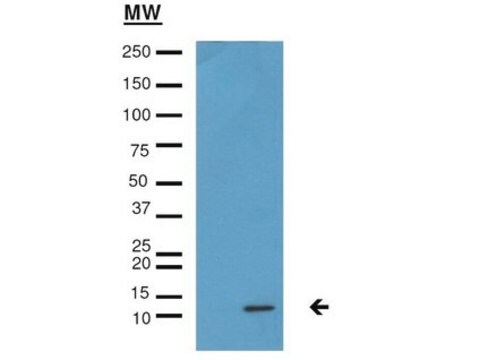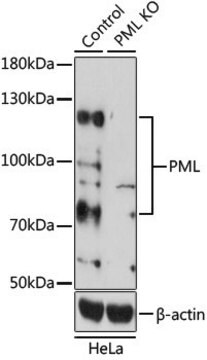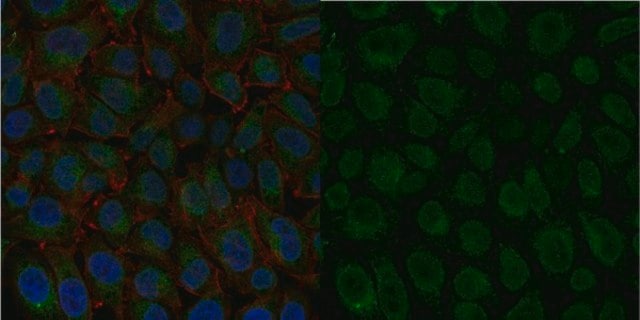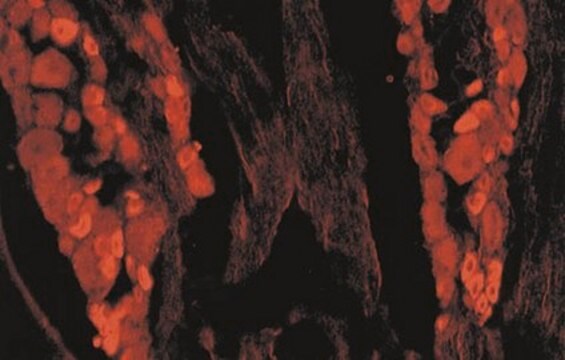07-1570-S
Anti-monomethyl Histone H4 (Lys20) Antibody, Trial Size
Upstate®, from rabbit
Sinónimos:
H4K20me1, Histone H4 (monomethyl K20), H4 histone family, member A, Histone 1, H4a, Histone cluster 1, H4a
About This Item
Productos recomendados
biological source
rabbit
Quality Level
antibody form
affinity isolated antibody
antibody product type
primary antibodies
clone
polyclonal
purified by
affinity chromatography
species reactivity
human
manufacturer/tradename
Upstate®
technique(s)
ChIP: suitable
dot blot: suitable
inhibition assay: suitable (peptide)
western blot: suitable
NCBI accession no.
UniProt accession no.
shipped in
wet ice
target post-translational modification
monomethylation (Lys20)
Gene Information
human ... H4C1(8359)
General description
Specificity
(Lys20), Mr 11 kDa.
Immunogen
(AKRHR[me1K]VLRD-C) of human Histone H4.
Application
Sonicated chromatin prepared from HeLa cells (2 X 106 cell equivalents per IP) was subjected to chromatin immunoprecipitation using 4 μg of either a negative control antibody or Anti-Monomethyl-Histone H4
(Lys20) antibody and the Magna ChIP A Kit (Cat. #17-610). Successful immunoprecipitation of monomethyl-histone H4 (Lys20)-associated DNA fragments was verified by qPCR using GAPDH coding region ChIP Primers versus Control Primers corresponding to the GAPDH promoter.
Please refer to the EZ-Magna ChIP A (Cat. # 17-408) or EZ-ChIP (Cat. # 17-371) protocol for experimental details.
Dot Blot Analysis : Absurance Histone H3 Antibody Specificity Array (Cat. No. 16-667) and Absurance Histone H2A, H2B, H4 Antibody Specificity Array (Cat. No. 16-665), which contain histone peptides with various modifications were probed with Cat. No. 07-1570-S Anti-monomethyl Histone H4 (Lys20) at 1:1000 dilution. Proteins were visualized using a Donkey anti-rabbit IgG conjugated to HRP and a chemiluminescence detection system.
Western Blot Analysis:
0.1 μg/mL of proteins were visualized using a goat anti-rabbit secondary antibody conjugated to HRP and a chemiluminescence detection system (Please see figures)
Peptide Blocking Assay:
40 μg of histone H4 peptide containing monomethyl Lys20 abolished detection of histone H4 by anti-monomethyl-Histone H4 (Lys20) in immunoblot analysis of acid extracts of HeLa cells (Please see figures).
Epigenetics & Nuclear Function
Chromatin Biology
Histones
Quality
Target description
Physical form
Storage and Stability
Handling Recommendations: Upon receipt, and prior to removing the cap, centrifuge the vial and gently mix the solution. Aliquot into microcentrifuge tubes and store at -20°C. Avoid repeated freeze/thaw cycles, which may damage IgG and affect product performance.
Analysis Note
HeLa cell acid extracts.
Legal Information
Disclaimer
Not finding the right product?
Try our Herramienta de selección de productos.
Storage Class
12 - Non Combustible Liquids
wgk_germany
WGK 1
flash_point_f
Not applicable
flash_point_c
Not applicable
Certificados de análisis (COA)
Busque Certificados de análisis (COA) introduciendo el número de lote del producto. Los números de lote se encuentran en la etiqueta del producto después de las palabras «Lot» o «Batch»
¿Ya tiene este producto?
Encuentre la documentación para los productos que ha comprado recientemente en la Biblioteca de documentos.
Nuestro equipo de científicos tiene experiencia en todas las áreas de investigación: Ciencias de la vida, Ciencia de los materiales, Síntesis química, Cromatografía, Analítica y muchas otras.
Póngase en contacto con el Servicio técnico






